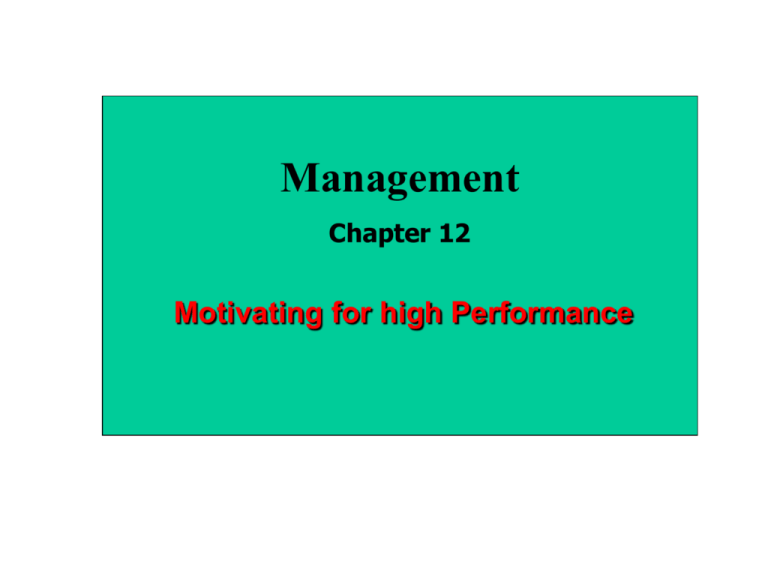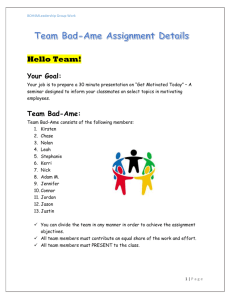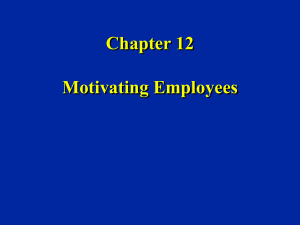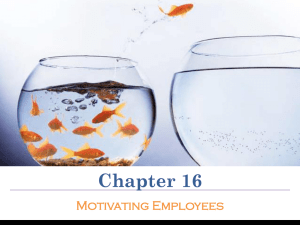Two-Factor Theory
advertisement

Management Chapter 12 Motivating for high Performance Motivation and Performance • Motivation –The willingness to achieve organizational objectives. • Motivation Process –Employees go from need to motive to behavior to consequence to satisfaction or dissatisfaction. 12–2 How Motivation Affects Performance • Expectations, Motivation, and Performance –Self-fulfilling prophecy • “If you believe you can, or if you believe you can’t, then you are right”—Henry Ford • If you think you will be successful, then you will be. • The Performance Formula –Performance = Ability x Motivation x Resources • For maximum performance levels, all three factors must be high. 12–3 Major Motivation Theories Content Motivation Theories Major Motivation Theories Process Motivation Theories Reinforcement Theory 12–4 Motivation: Content Theories • Content Motivation Theories –Focus on identifying and understanding employees’ needs. • Hierarchy of needs theory • ERG theory • Two-factor theory • Acquired needs theory 12–5 Maslow’s Hierarchy of Needs Theory • Hierarchy of Needs – Only unmet needs motivate. – People’s needs are arranged in order of importance for basic to complex. • Satisfaction of lower level needs precedes satisfaction of higher levels needs. – There are five classifications of needs: • Physiological Needs: These are people’s primary or basic needs: air, food, shelter, etc. • Safety Needs: Once the physiological needs are met, the individual is concerned with safety and security. • Social Needs: After establishing safety, people look for love, friendship, acceptance, and affection. • Esteem Needs: They include status, self-respect, recognition, and a feeling of self-confidence and prestige. • Self-Actualization Needs: These include developing one’s full potential through growth, achievement, and advancement. 12–6 How Managers Motivate with Maslow’s Hierarchy of Needs Theory Exhibit 12–2 12–7 Alderfer’s ERG Theory • ERG theory –Proposes that employees are motivated by three needs: • Existence: physiological and safety needs. • Relatedness: social needs. • Growth: esteem and actualization. –Needs can be active on more than one level at the same time. • Starving actor: being hungry and wanting fame and fortune. 12–8 TWO factors Theory Two-Factor Theory • Herzberg’s Two-factor theory proposes that employees are motivated by motivators rather than maintenance factors. – Maintenance factors are also called hygiene motivators because motivation comes from outside the job itself; they include pay, job security, title; working conditions; fringe benefits; and relationships. – Motivators are called intrinsic motivators because motivation comes from the work itself’ they include achievement, recognition, challenge, and advancement. • Herzberg Two continuums exist: not dissatisfied with the environment (maintenance) to dissatisfied, and satisfied with the job itself (motivators) to not satisfied. • Herzberg contended that providing maintenance factors will keep employees from being dissatisfied, but it will not make them satisfied or motivate them. 12–9 Herzberg’s Two-Factor Theory Exhibit 12–3 12–10 McClelland’s Acquired Needs Theory • Acquired Needs Theory –Proposes that employees are motivated by their need for achievement, power, and affiliation. • Need for Achievement (n Ach): the desire for responsibility and accomplishment. • Need for Power (n Ach): the desire to control the situation and influence others. • Need for Affiliation (n Aff): the tendency to be liked and to seek close relationship with others. 12–11 A Comparison of Four Content Motivation Theories Exhibit 12–4 12–12 Motivation: Process Theories • Process Motivation Theories –Focus on understanding how employees choose behavior to fulfill their needs. • Equity theory • Goal-setting theory • Expectancy theory 12–13 Adams’s Equity Theory • Equity Theory –Proposes that employees are motivated when their perceived inputs equal outputs. –People compare their inputs (contributions to the organization) and outputs (rewards) to that of relevant others and conclude that they are: • Underrewarded • Overrewarded • Equitably rewarded 12–14 Goal-Setting Theory • Goal-Setting Theory –Proposes that achievable but difficult goals motivate employees, leading to higher levels of motivation and performance. • Goals provide an attractive challenge to high-performing individuals who have a strong need for achievement. • Goals provide a sense of purpose—why we are working to accomplish a given task. • Goals require action plans to achieve goals and measure progress. 12–15 Vroom’s Expectancy Theory • Expectancy Theory –Proposes that employees are motivated when they believe they can accomplish the task and the rewards for doing so are worth the effort. –Motivation = expectancy x valence • Expectancy: the person’s perception of his or her ability to accomplish an objective. • Valence: the value the person places on the outcome or reward for his or her performance. 12–16 Reinforcement Theory • Reinforcement Theory –Proposes that through the consequences for behavior employees will be motivated to behave in predetermined ways. Stimulus Responding Behavior Consequences of Behavior (Reinforcement) 12–17 Types of Reinforcement • Positive Reinforcement –Encouraging continued behavior by offering attractive consequences (rewards) for desirable performance. • Avoidance Reinforcement (Negative Reinforcement) –Encouraging continued desirable behavior to avoid a negative consequence. 12–18 Types of Reinforcement (cont’d) • Extinction –Discouraging undesirable behavior by withholding reinforcement when the behavior occurs. • Punishment –Providing an undesirable consequence for the undesirable behavior. 12–19 Schedules of Reinforcement • Continuous Reinforcement –Each and every desirable behavior is reinforced. • Intermittent Reinforcement Schedules –Time-based • Fixed interval • Variable interval –Output-based • Fixed ratio • Variable ratio 12–20 Giving Praise 1. Tell the employee exactly what was done correctly. 2. Tell the employee why the behavior was important. 3. Stop for a moment of silence. 4. Encourage repeat performance. Model 12–1 12–21 The Motivation Process with the Motivation Theories Exhibit 12–6 12–22








